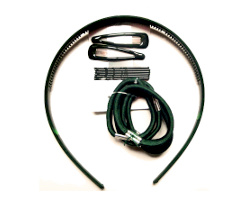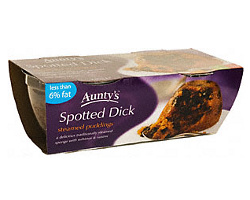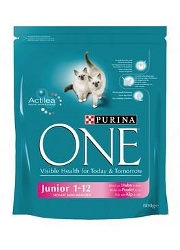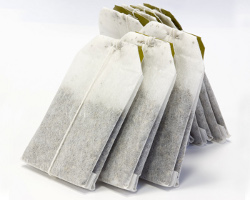 We’ve had an email from Donna:
We’ve had an email from Donna:
My 12 year old daughter has just had her long long lovely hair cut off and when we got home from the hairdressers, she cleared out a big box of hair bobbles, loop bands, Alice bands, scrunchies, ribbons, all sorts of things like Claire’s Accessories threw up in a box and told me she’d “never need them again”! They’re all used as far as I know so I don’t think a charity shop would want them. Would anywhere else take them?
(Heh, shop vomit.)
Perhaps Donna’s daughter will be better keeping on top of her new ‘do but I regularly need elastics when my (supposedly short) hair gets a bit long – so if I was her, I wouldn’t throw *everything* away. An alice band and clips/barrettes are always super useful for those days when everything’s pointing in the wrong direction.
If she has a lot of them, chances are most of them will probably be in good condition – how about washing them and encouraging her to sell them at a car boot sale? You could declutter some other stuff at the same time :)
I’d yoink the ribbons for craft stuff and the little elastics that are essentially a fabric covered elastic band as useful as gentler-than-normal elastic bands – I’ve heard them used in place of elastic bands in a number of household applications, but the only one I can think of at the moment is around the bottom of bouquets — the elastic is less likely to damage the stems. Any other suggestions for that?
And what about other ways to pass on or reuse all Donna’s daughter’s hair bobbles?
Categories: bathroom, clothes and fabric, items
Posted by louisa
on 13 June 2011
 We’ve had an email from Debbie:
We’ve had an email from Debbie:
Any ideas what we can do with individual microwave pudding pots from the supermarket? They’re plastic.
First up, as always, reduce if you can – I know those puddings are convenient but it doesn’t take that much longer to make your own with a microwave (for example, a syrup pudding only takes about five minutes from scratch and there are plenty of “chocolate pudding in a mug” recipes out there). Or, if there is more than one of you puddinging and you *have* to buy one, getting a bigger single pudding instead of lots of little ones – the overall amount of packaging will be slightly less, and the bigger pot will be more reusable.
Bringing us neatly onto reuses: any suggestions? I suspect there will be considerable overlap with yoghurt pots – but the ones I’ve seen are a little more shapely than those so that may allow other reuses.
The little ones are fine as seedling starter pots (make holes in the bottom for drainage), or as little paint pots. They’d make dome-shaped jelly moulds for individual jellies – or for making your own microwave puddings! You could also cross the plant pot/dessert mould ideas over and make dirt puddings ;) Any other ideas?
As for actual recycling, does anyone know what number plastic they are? From a bit of Googling around, I think they’ll be number 5, polypropylene – but I’ll check next time I’m at the supermarket.
Categories: items, kitchen, packaging
Posted by louisa
on 8 June 2011
 Leo emailed to ask:
Leo emailed to ask:
Hi, your website is great. I’m interested in reusing broken ceramics, terracotta tiles, stone etc. to do a floor mosaic. Do you have any advice about installing this, e.g. cheap or recyclable adhesive, mortar etc.?
The only time I’ve make a “crazy” tile mosiac, I had some normal tile adhesive and grout leftover from a project so just used that. Has anyone else used anything else?
And, while Leo doesn’t explicitly ask for it, anyone got any other advice for building such a mosiac recycling and upcycling various things?
(Photo by stay4while)
Categories: household, reverse this
Posted by louisa
on 7 June 2011
 Shar left us a message on our “Suggest An Item” page:
Shar left us a message on our “Suggest An Item” page:
I have increasing numbers of empty Purina one cat food bags.
Because they are plastic foil they are not accepted by my local council for recycling. [I’m in uk]
Bag has a zip lock. Sturdy item. Not sure what to do with them. I would gladly donate them to somewhere if I knew a place that re-used them.
size: 23 cm width / 27 cm height. Folds flat. At present these add to landfill. {cringes}
Any ideas how to recycle / re-use? [I do not have a garden or balcony, so no independent outdoor space]
We’ve asked about plastic pet food bags before but it seemed to be slanted towards big dog food bags – the size that can be used as grow bags or sealed rubbish/garbage bags. So any ideas for these smaller ones?
The zip lock element is interesting – making them easily water resistant if not full-on waterproof. I was reading the other day about the importance of having copies of all important paperwork (personal identification, bank details, insurance stuff) grouped together in a sealed easy-to-grab folder in case of an emergency – but someone else on the forum pointed out that such a file would be an identity thief’s dream — putting it in something like a couple of Purina bags would make it a lot less obvious. That would only use up one or two though – so any other suggestions?
(I’ve contacted Purina to see if they have any recycling advice: if they reply, I’ll add the info here.)
Categories: household, items, packaging
Posted by louisa
on 6 June 2011
 Over on the Really Good Life the other day, I listed all the consumables I used in one day and their packaging. I think it’s easy to become blind to things you routinely use and listing them helped me realise where I was creating unnecessary waste/exposing myself to unnecessary synthetic chemicals in my day to day life. I’m going to do the exercise again a few times over the next couple of weeks to get a more accurate broader picture (for example, on the first day, I didn’t do any household cleaning or laundry, or much cooking).
Over on the Really Good Life the other day, I listed all the consumables I used in one day and their packaging. I think it’s easy to become blind to things you routinely use and listing them helped me realise where I was creating unnecessary waste/exposing myself to unnecessary synthetic chemicals in my day to day life. I’m going to do the exercise again a few times over the next couple of weeks to get a more accurate broader picture (for example, on the first day, I didn’t do any household cleaning or laundry, or much cooking).
The reason I’m mentioning it here is two-fold — firstly, I thought it was a useful exercise and I’d recommend it anyone wanting to reduce. Secondly, I categorised my teabags as “probably not compostable” so possibly destined for landfill, which caused a bit of discussion in the comments (we do actually compost our teabags but not without a little hesitation). As I mentioned over there, Alice in Blogland looked into the issue a few years ago and found that teabags often include synthetic material in the heat sealed bit – the paper bag and the leaves are but not everyone wants synthetic materials in their compost heap. Without the heat sealed bit (typically food grade polypropylene), the bags wouldn’t stay sealed during manufacture and use.
It’s four years since Alice’s research though and the corporate world has made many green(washing) steps forward since then – so I thought it might be useful to check the situation again. I contacted ten tea companies and asked them whether I could compost their tea bags. Here are the responses:
Tetley
Tetley got back to me very, very quickly – which makes me think they get asked this question quite a lot:
The material used to make the actual tea bag is a mixture of mainly cellulose fibres and a small amount of polypropylene fibres to give the heat seal. Under normal composting conditions the cellulose fibres will break down, as will the tea, leaving the very small polypropylene fibres which are normally so small they are not seen. It does however take a reasonable amount of time to do this and really needs to be placed into a ‘proper’, established compost heap.
If it has not broken down it may be because:
- It has not been left long enough
- It hasn’t spent enough time at the centre of the heap where the temperature is higher
- It has been put on the garden, not on a compost heap
- It hasn’t been mixed with enough vegetable or organic matter
- The worm population is not high enough
The packs themselves are not compostable. We are working with our packaging suppliers on an ongoing basis as they are currently unable to supply us with fully biodegradable packaging that we can use for our packs. Comments like yours actually help us keep the pressure on our suppliers to produce a solution.
Continue Reading →
Categories: food, items, packaging
Posted by louisa
on 2 June 2011
 We’ve had an email from Donna:
We’ve had an email from Donna:


 We’ve had an email from Debbie:
We’ve had an email from Debbie: Leo emailed to ask:
Leo emailed to ask: Shar left us a message on our “Suggest An Item” page:
Shar left us a message on our “Suggest An Item” page: Over on
Over on 














